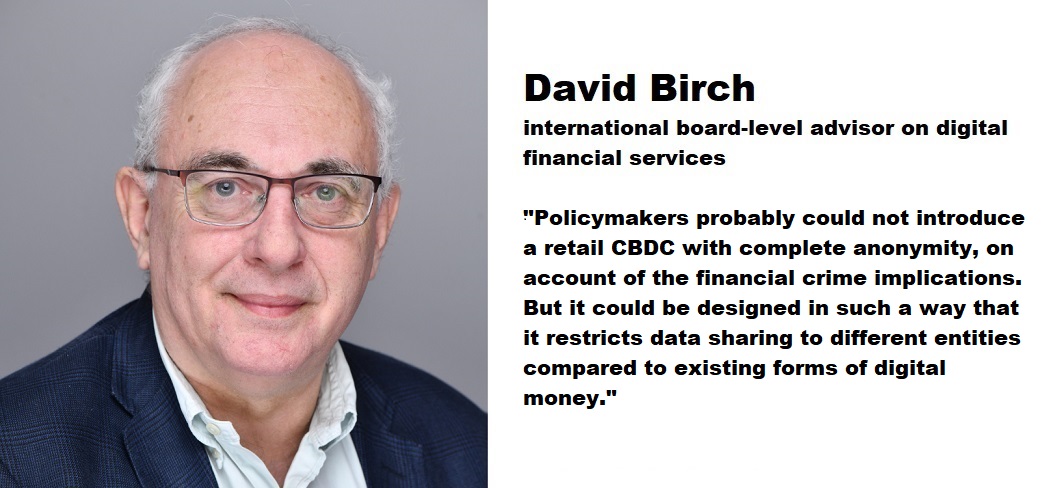
an article written by David Birch, author, advisor and commentator on digital financial services.
Research from the Reserve Bank of Australia (RBA) last year showed up some interesting consumer attitudes around a digital fiat currency. At high level it told us that Aussies do not care about safety (they do not distinguish between commercial bank money and central bank money as nerds like me do) but they do care about privacy, to the extent that they are willing to pay for it. Interesting.
Money And Messaging
The RBA’s paper explored the merits of a retail central bank digital currency (CBDC) in Australia, focusing on the extent to which consumers would value having access to a digital form of money that is even safer and potentially more private than commercial bank deposits. Safety did not seem to be a selling point, which is consistent with bank deposits in Australia already being perceived as a safe form of money (because of a deposit protection scheme) and physical cash continuing to be available as an alternative option. So therefore you cannot charge consumers for a CBDC on the basis of safety.
When it comes to privacy though, there is a different perception. Consumers say that they value transaction anonymity and that they care about who transaction data is shared with, to the extent that they are prepared to pay A$5 more for an account that shares transaction data with the central bank instead of with commercial banks, even assuming that the financial crime authority, the Australian Transaction Reports and Analysis Centre (AUSTRAC), can access the transaction data in either case.
In Australia this would generate around $60m per annum to contribute to the running of the system. Is privacy a way of paying for a digital currency then? By paying to opt out of surveillance (just like with adverts on YouTube) privacy-conscious users with money could support the system and subsidise other users.
But hold on. This was in Australia. A recent and detailed study from the Bank of Israel on public attitudes points points in a different direction because unlike in other countries, such as the United States, Israelis did not note concern about privacy as a major worry. Clearly there are cultural factors at work here, but it might be possible to design a system to appeal to both more and less privacy-sensitive consumers.
Paradox
Trying to think this through it seems to me that there is something of a paradox here in mental transaction models. The average consumer wants anonymity for their own payments because they are not crooks (and their purchasing decisions are no-one’s business except theirs and the merchant’s). On the other hand, the average consumer (not to mention the average law enforcement agent) doesn’t want anonymity for terrorists, lobbyists or fraudsters.
The Bank of England’s fintech director Tom Mutton said in a speech a while back that privacy was “a non-negotiable” for a retail CBDC. But not unconditional privacy, for course. The Bank of Canada published a a staff analytical note around that same time on the risks associated with CBDCs stating that central banks should mitigate risks such as anonymity present in digital currencies. Note the formulation of anonymity as a “risk”.
So how might this paradox be resolved? Well, one option might be to assume that the anonymous cash will be used primarily by criminals and possession of it will be taken to be prima facie evidence of criminality. Thus law enforcement resources can be targeted. Hence you could argue that anonymity can actually help law enforcement to carry out old-fashioned police work. After all, in an anonymous world no-one knows you’re a dog but no-one knows that you’re from the FBI either (or if you are a bot either, so I would rather assume that the police will have large-scale big data analysis and pattern recognition and machine learning and all sort of other things to help them).
Anyway, whether anonymous digital currency succeeds or not, the general principle strikes me as unlikely to vanish and it makes consideration of the institutions and structures that are needed in the presence of anonymous electronic money all the more pressing.
Incentives And Subsidies
I have often discussed the need for privacy but not for anonymity, so bringing in financial subsidies is an interesting idea to play with. Policymakers probably could not introduce a retail CBDC with complete anonymity, on account of the financial crime implications. But it could be designed in such a way that it restricts data sharing to different entities compared to existing forms of digital money. The European Central Bank (ECB) has talked about allowing anonymity for small transactions but I cannot see what the point of this is (if transactions are anonymous, how would you know that the same drug dealer just send a million ten dollar payments to the same corrupt politicians).
The idea that counterparties can choose whether a transaction is visible or not is interesting and under explored. You could if you wanted to take the paying for invisibility idea even further and offer people complete anonymity for their transactions in return for a holding tax to cover the cost to society of the inevitable tax evasion, money laundering and other activities detrimental to society. I would think a tax of perhaps 30-40% would be about right. All of which reminds me of the concept of light transactions and dark transactions that artist Austin Houldsworth put forward many years ago.
Privacy, not anonymity, should be the goal and if some people want to pay more to get more of it, then why not let them and use that money to subsidise the provision of basic wallets to the less well-off?
Banking 4.0 – „how was the experience for you”
„To be honest I think that Sinaia, your conference, is much better then Davos.”
Many more interesting quotes in the video below: